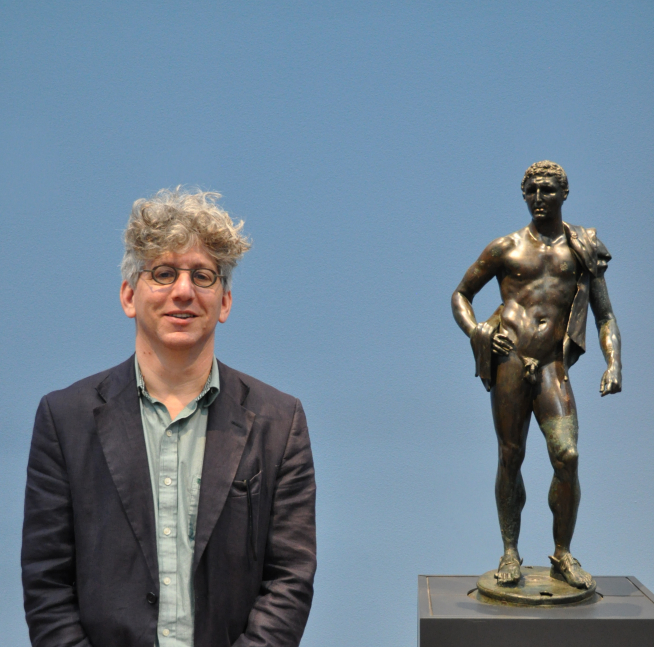The Legacy of Pompeii
Posted: November 10, 2015 - 12:57 , by ROM
Categories:
Ancient Cultures, Pompeii |
Comments () | Comment
Getty Villa antiquities curator Kenneth Lapatin talks about the themes of his upcoming lecture “The Enduring Legacy of Rome” at the ROM on November 17.
Kenneth Lapatin is a curator at the Getty Villa. Trained as a classical archaeologist, he holds degrees from the University of California at Berkeley and Oxford. Before coming to the Getty in 2002 he was a professor of art history at Boston University. Lapatin has curated exhibitions on Greek vase painting, ancient gems and their lasting allure, Pompeii and its modern reception, Roman silver, and, most recently, Hellenistic bronze statuary. He has a particular interest in the luxury arts of Greece and Rome, as well as historiography and forgery. He is the author/editor of several exhibition catalogues and museum guides, as well as Chryselephantine Statuary in the Ancient Mediterranean World; Mysteries of the Snake Goddess: Art, Desire, and the Forging of History; Greek Art and Architecture; and, most recently, Luxus: The Sumptuous Arts of Greece and Rome.
Sascha Priewe, Managing Director, ROM (ROM): What enticed you to devote your life to the study of Classical Antiquity?
Kenneth Lapatin (KL): It was not so much a decision as a gradual process. I was always interested in history, and as an undergraduate at Berkeley, led by great teachers, I eventually worked my way backwards to the Middle Ages, then Rome, then Greece (and eventually also did some work on the Bronze Age). In addition to the very large allure of Mediterranean travel, and the great beauty of the artifacts - statues, frescoes, gems, vases, etc. - is the excitement of discovery. And not only of new finds coming quite regularly from the ground or the sea, but also the possibility of new interpretations as our knowledge grows and we ask new questions. Some things about antiquity we will never know, but we can guess, discuss, debate. This is very stimulating.
ROM: When did you first visit Pompeii? What captured your imagination?
KL: My first visit to Pompeii was in 1981. After spending several weeks in Rome I took the train down to Naples to explore Pompeii, Herculaneum, and other sites. I was struck by the size of the site and the preservation - how immediate and everything was: the roads, houses, frescoes, even fast food shops.
ROM: In your lecture you will be talking about the legacy of Pompeii. How has Pompeii shaped what we know about the world of the Romans?
KL: Prior to the rediscovery of Pompeii and the other sites buried by Vesuvius the study of the Roman world was based to a very large degree on texts - the writings of ancient historians and inscriptions on stone - as well as the well-preserved marble architecture of Rome itself and a few other cities. Pompeii was not really a very important city in antiquity. Not like Rome or Alexandria in Egypt. And that is why it is so significant to us today: precisely because it was more of a run-of-the-mill town. There were thousands of Pompeiis throughout the Roman world, about which we know very little. Pompeii is exceptional because paradoxically its sudden destruction preserved it, and with it a wealth of information about everyday life in a regular town.
ROM: How is the legacy of Pompeii felt today? Why does Pompeii still matter?
KL: Its legacy today in many ways outstrips its importance in antiquity, and its well-preserved material culture provides a great deal of evidence for ancient life that survives nowhere else. But Pompeii is also important to us as a kind of type-site for sudden destruction, for life unexpectedly snuffed out. For almost three centuries since it was first rediscovered, Pompeii has functioned as the base-line for measuring modern disasters. The great Lisbon earthquake, the catastrophic destruction of American cities during the Civil War, the 1906 San Francisco earthquake, the bombing of Hiroshima and Nagasaki have all been compared to the destruction of Pompeii.
ROM: What developments in the arts do we owe to Pompeii?
KL: The Pompeian style of Painting was revived in the later 18th century and was quite popular in the 19th, and developments in domestic architecture as well as household plumbing were greatly influenced by finds at the site.
ROM: In what ways is our knowledge about Pompeii filtered by those who started excavating the site in a couple of hundred years ago? What is the legacy of this work?
KL: Archaeologists often find what they are looking for, and often don't see what they are not looking for, and Pompeii is no different. Thus the early search for sculptures and paintings to decorate the palaces of the Kings of Naples has been replaced by a more holistic desire to understand everyday life in the Roman empire, and most recently by a great interest in non-elites, including women, children, and slaves. It is also interesting to realize that for almost three centuries excavations in the Vesuvian region have been a laboratory that has employed cutting edge technology, from the tunneling techniques derived from mining engineering employed by the first diggers, to more modern mapping and drawing techniques, to the latest in computer and imaging techniques today.
ROM: Fascinating. Thank you very much, Ken. I look forward to welcoming you at the ROM very soon!
Tickets to Kenneth Lapatin’s lecture “The Enduring Legacy of Rome” on November 17 are still available. Book now!
The lecture is part of The World of Pompeii featuring lectures and event alongside our special exhibition Pompeii: In the Shadow of the Volcano. See links for information and tickets.
